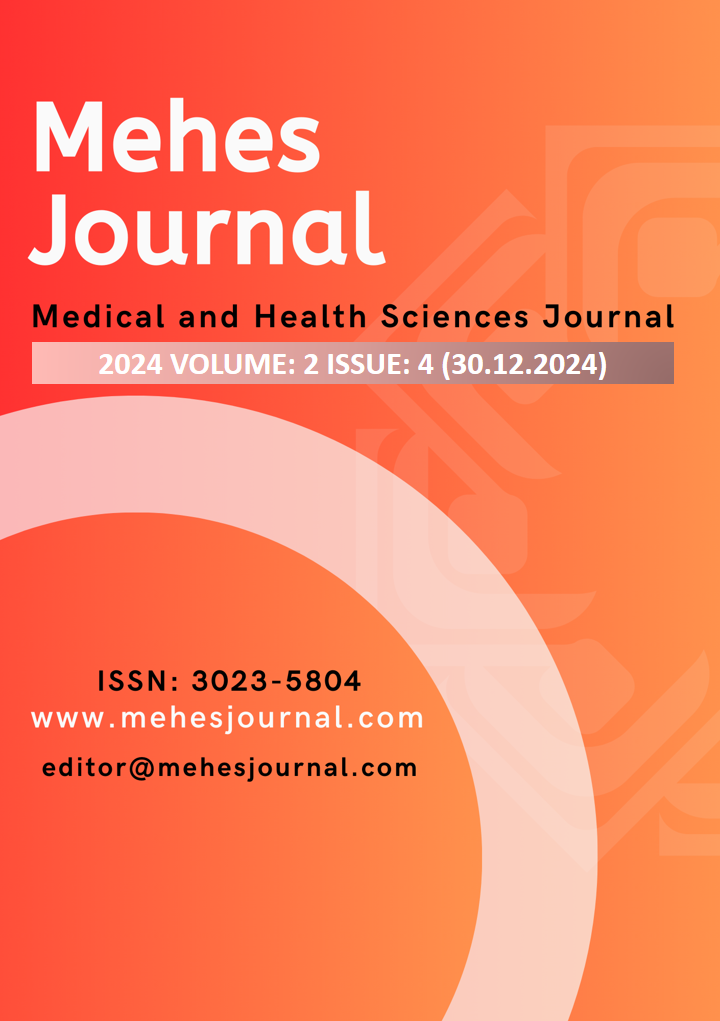Ethanol Extract of Alcea Rosea Flowers Has a Suppressive Effect on Adipogenesis Under In Vitro Conditions
DOI:
https://doi.org/10.5281/zenodo.14569158Keywords:
Adipogenesis, Alcea rosea, ObesityAbstract
Objective: Obesity is a disease that causes serious health complications and is seen all over the world and there is a need to develop new long-term and effective alternative anti-obesity strategies. Natural and herbal products are widely used in treating obesity due to their various biological activities, including anti-inflammatory, antioxidant, and anti-obesity effects. It was aimed to investigate the effects of Alcea rosea flower on lipid accumulation and PPARγ and CERBβ biomarkers that have a key role in adipogenesis in this study.
Material and Methods: To mimic adipogenesis in vitro, human precursor adipocyte cells were used and grown in a preadipocyte growth medium at 37°C in a 5% CO2 incubator. The grown cells were seeded at 105 cells/well, then divided into 4 groups, and different doses (50 μg 100 μg 150 μg and 200 μg) of Alcea rosea ethanol extract (ARE) and differentiation medium were applied to each group. At the end of the 15th day, Oil O Red staining was performed to measure lipid accumulation. PPARγ and C/EBPβ gene expressions were determined by the RT-PCR method.
Results: Lipid accumulation was significantly suppressed (p<0,05) at all ARE doses. In addition, ARE suppressed PPARγ gene expression at all doses, but the suppression was statistically significant only at the 100 μg applied level (p=0,05). In the analysis of the C/EBPβ gene, suppression was observed at all doses, but the suppression was found to be statistically significant only at the 50 μg (p=0,04) and 100 μg (p=0,04) doses.
Discussion and Conclusion: As a result, it was determined that the applied ARE concentrations suppressed adipogenesis and had anti-obesity properties, but it is recommended that further studies support the study findings.
References
Guilherme A, Virbasius JV, Puri V, Czech MP. Adipocyte dysfunctions linking obesity to insulin resistance and type 2 diabetes. Nat Rev Mol Cell Biol. 2008;9(5):367-77.
Janani C, Ranjitha Kumari BD. PPAR gamma gene--a review. Diabetes Metab Syndr. 2015;9(1):46-50.
Guo L, Li X, Tang QQ. Transcriptional regulation of adipocyte differentiation: a central role for CCAAT/enhancer-binding protein (C/EBP) β. J Biol Chem. 2015;290(2):755-61.
Mert T, Fafal T, Kıvcak B, and Ozturk HT. Antimicrobial and cytotoxic activities of the extracts obtained from the flowers of Alcea Rosea L. Hacettepe University Journal of the Faculty of Pharmacy. 2010;30(1):17-24.
El Ghaoui WB, Ghanem EB, Chedid LA, Abdelnoor AM. The effects of Alcea rosea L., Malva sylvestris L., and Salvia libanotica L. water extracts on the production of anti-egg albumin antibodies, interleukin-4, gamma interferon and interleukin-12 in BALB/c mice. Phytother Res. 2008;22(12):1599-604.
Zhang Y, Jin L, Chen Q, Wu Z, Dong Y, Han L, etal. Hypoglycemic activity evaluation and chemical study on hollyhock flowers. Fitoterapia. 2015;102:7-14.
Shahabipour F, Caraglia M, Majeed M, Derosa G, Maffioli P, Sahebkar A. Naturally occurring anti-cancer agents targeting EZH2. Cancer Lett. 2017;400:325-335.
Choi ES, Cho SD, Shin JA, Kwon KH, Cho NP, Shim JH. Althaea rosea Cavanil and Plantago major L. suppress neoplastic cell transformation through the inhibition of epidermal growth factor receptor kinase. Mol Med Rep. 2012;6(4):843-7.
You JS, Lee YJ, Kim KS, Kim SH, Chang KJ. Anti-obesity and hypolipidaemic effects of Nelumbo nucifera seed ethanol extract in human pre-adipocytes and rats fed a high-fat diet. J Sci Food Agric. 2014;94(3):568-75.
Swamy GM, Meriga B. Therapeutic effect of Moringa oleifera leaf extracts on oxidative stress and key metabolic enzymes related to obesity. International Journal of Pharmaceutical Sciences and Research. 2020;11(4):1949-1957.
Torres-Villarreal D, Camacho A, Castro H, Ortiz-Lopez R, de la Garza AL. Anti-obesity effects of kaempferol by inhibiting adipogenesis and increasing lipolysis in 3T3-L1 cells. J Physiol Biochem. 2019;75(1):83-88.
Zhou J, Yoshitomi H, Liu T, Zhou B, Sun W, Qin L, et.al. Isoquercitrin activates the AMP-activated protein kinase (AMPK) signal pathway in rat H4IIE cells. BMC Complement Altern Med. 2014;14:42.
Lee SH, Kim B, Oh MJ, Yoon J, Kim HY, Lee KJ, et.al. Persicaria hydropiper (L.) spach and its flavonoid components, isoquercitrin, and isorhamnetin, activate the Wnt/β-catenin pathway and inhibit adipocyte differentiation of 3T3-L1 cells. Phytother Res. 2011;25(11):1629-35.
Dudek M, Matławska I, Szkudlarek M. Phenolic acids in the flowers of Althaea rosea var. nigra. Acta Pol Pharm. 2006;63(3):207-11.
Hsu CL, Yen GC. Effects of flavonoids and phenolic acids on the inhibition of adipogenesis in 3T3-L1 adipocytes. J Agric Food Chem. 2007;55(21):8404-10.
Seo CH, Yi B, Oh S, Kwon SM, Kim S, Song NJ, et.al. Aqueous extracts of hulled barley containing coumaric acid and ferulic acid inhibit adipogenesis in vitro and obesity in vivo. Journal of Functional Foods. 2015;12: 208-218.
Park J, Cho SY, Kang J, Park WY, Lee S, Jung Y, et.al. Vanillic Acid Improves Comorbidity of Cancer and Obesity through STAT3 Regulation in High-Fat-Diet-Induced Obese and B16BL6 Melanoma-Injected Mice. Biomolecules. 2020;10(8):1098.
Wang Q, Wang ST, Yang X, You PP, Zhang W. Myricetin suppresses differentiation of 3T3-L1 preadipocytes and enhances lipolysis in adipocytes. Nutr Res. 2015;35(4):317-27.
Park HS, Kim SH, Kim YS, Ryu SY, Hwang JT, Yang HJ, et.al. Luteolin inhibits adipogenic differentiation by regulating PPARgamma activation. Biofactors. 2009;35(4):373-9.
Oh JH, Karadeniz F, Lee JI, Seo Y, Jang MS, Kong CS. Effect and comparison of luteolin and its derivative sodium luteolin-4′-sulfonate on adipogenic differentiation of human bone marrow-derived mesenchymal stem cells through AMPK-mediated PPARγ signaling. Evidence-Based Complementary and Alternative Medicine. 2020;1-8.
Park M, Sharma A, Lee HJ. Anti-Adipogenic Effects of Delphinidin-3-O-β-Glucoside in 3T3-L1 Preadipocytes and Primary White Adipocytes. Molecules. 2019;24(10):1848.
Ahn J, Lee H, Kim S, Park J, Ha T. The anti-obesity effect of quercetin is mediated by the AMPK and MAPK signaling pathways. Biochem Biophys Res Commun. 2008;373(4):545-9.
Park UH, Jeong JC, Jang JS, Sung MR, Youn H, Lee SJ, et.al. Negative regulation of adipogenesis by kaempferol, a component of Rhizoma Polygonati falcatum in 3T3-L1 cells. Biol Pharm Bull. 2012;35(9):1525-33.
Downloads
Published
How to Cite
Issue
Section
License
Copyright (c) 2024 MEHES JOURNAL

This work is licensed under a Creative Commons Attribution 4.0 International License.










